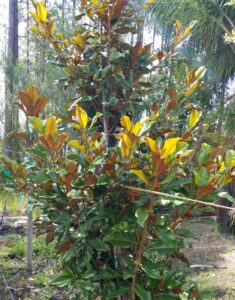S & J Nursery’s Guide to Growing
Brakens Brown Beauty Magnolia
in the Northeast Florida Landscape
( Magnolia grandiflora ‘Brakens Brown Beauty’ )
Magnolia Brackens Brown Beauty Origins:
– A selection of the North American Native Magnolia Grandiflora form Ray Brackens Nurseries in South Carolina.
Brackens Brown Beauty Magnolia Preferred Exposure:
– Full sun to partial sun/shade situations are tolerated in the North Florida | Jacksonville | St. Augustine area landscape.
Magnolia Brackens Brown Foliage | Bark:
– Brackens Brown Beauty Magnolia remains evergreen keeping its foliage in the winter season.
– Foliage of the Brackens Brown Beauty Magnolia is extremely large and showy in comparison to other Southern Magnolias. The leaves are a deep dark shiny green on the surface with a deep dark brown underneath. Many consider this to be a superior selection on Magnolia and indeed it has made quite an impact since its introduction.
Brackens Brown Beauty Magnolia Soil Preference / Salt tolerance:
– Magnolia Brackens Brown beauty will prefer slightly acidic soil but will tolerate sand, loam and clay soil makeups equally well.
-Only moderately salt tolerant
Magnolia Brackens Brown Beauty Size Variance:
– Can reach sizes of 30-50 feet H | and spreading narrowly only to about 15- 25 ft feet wide making it fit nicely in the medium sized category of Southern Magnolias
Magnolia Brackens Brown Beauty Growth Habit:
– Magnolia Brackens Brown Beauty are densely foliated trees with a more narrow than typical of the species but pyramidal growth habit and tend to have branches very near ground level unless pruned up by removing the lower branches to expose underneath the tree.
Magnolia Brackens Brown Beauty Growth Rate:
– Brackens Brown Beauty Magnolia trees are fast growers.
Magnolia Brackens Brown Beauty Bloom:
– These trees have a large and highly fragrant creamy white leathery blooms that reach 6 inches across with a central cone that will enlarge and open up after the petals have gone to expose beautiful bright red seeds that are utilized by various wildlife in the North Florida | Jacksonville | St.
Augustine area landscapes and gardens.
– Its no wonder these impressive blooms are the state flower for both Louisianan and Mississippi.
Magnolia Brackens Brown Beauty Water Requirements:
– Plants will need daily water after being planted from a container or transplanted into the landscape and supplemental irrigation during periods of reduced local rainfall for the first season or two.
Butterfly or Bird Attracting:
– Seed cones are utilized by various wildlife.
Best Uses For Brackens Brown Beauty in the North Florida | Jacksonville | St. Augustine landscape:
– Southern Magnolia Brackens Brown Beauty is an ideal selection for a moderate to large garden area or where space limitations would make the broader spreading Southern Magnolia selections out of place. Its more columnar growth habit also makes it ideal for a lawn shade tree for the front or back yard, Magnolia D.D. Blanchard will supply excellent coverage to screen large unwanted views and will remain evergreen in the winter time and have the added bonus of the large fragrant blooms.
– Use Southern Magnolia D.D. Blanchard as a foundation accent only when you will be able to place it 10-12 ft from the foundation of a home, not because the roots are problematic but because of the multitude of lateral
growing branches that will within 10-20 years of being planted in the landscape be growing 7-10+ feet from the trunk. Magnolia D.D. Blanchard can be planted closer to structures where you will be clearing the lower branches up and away from impediments such as sidewalks, sheds, garages etc. – Southern Magnolias also make excellent street trees.
Care of Southern Magnolia Brackens Brown Beauty:
– Although Magnolia trees can be planted from a container into the
landscape any time of the year in our North Florida | Jacksonville | St. Augustine area landscapes, Magnolias root systems are very wide for their size making transplanting sometimes difficult, so if you decide to move one from one location to another in the yard be sure to do it in winter or spring for the best result possible.
– Water every day during the establishment period, See watering your newly planted trees for more information. Magnolia’s must be
watched for the first one to two seasons after being planted
or transplanted in the landscape and supplemental water supplied in any time of drought. They are slower to establish themselves into
the landscape than many other trees and should be watered
well once a week when local rainfall is scarce.
– Magnolias respond well to pruning, when shaping a younger tree
they should be pruned 6 inches deeper than where you would like to see the re-growth appear. Everywhere you trim the tree will sprout new growth and begin to branch out and fill in. So if you have a scarcely foliated Magnolia tree get out the pruners and remove as many growing tips as possible, prune deeper into the branch in scarcely foliated areas to get them to branch out and fill in the gaps.
– Magnolias have lots of branches all though they will be smaller in diameter in comparison to other larger growing shade trees like an Oak. Prune out the occasional occurrence of a branch at a sharper angle than 45 degrees or if damaged etc. by removing the branch all the way back to the trunk.
– Provide a 1 ft diameter circle of mulched area where grass is kept from growing for each inch of caliper (or diameter) of trunk measured 4 inches from the ground level.
– Fertilize each spring with a mixture of Milorganite and a slow release poly coated plant food such as Osmocote or Stay Green general purpose plant food, sprinkling the fertilizer around the mulch circle underneath the foliage of the tree.

